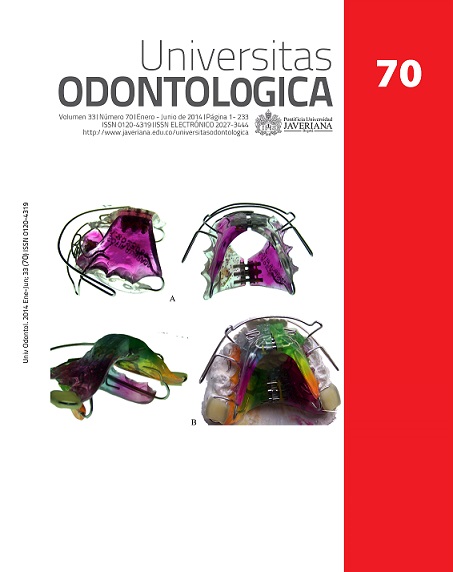Resumen
ANTECEDENTES: la oclusión funcional necesita que los dientes estén en completa alineación con un adecuado acople anterior y guía de protección canina. OBJETIVO: evaluar la altura de la cresta ósea alveolar después de realizar tracción ortodóntica de caninos impactados en el maxilar superior, comparados con un grupo control de caninos contralaterales erupcionados naturalmente en pacientes con edades entre 10 y 18 años. MATERIALES Y MÉTODOS: la muestra estuvo conformada por 10 caninos impactados y 10 caninos control. Previa localización radiográfica de los caninos impactados y su respectiva exposición quirúrgica se realizó la tracción elástica para posicionarlos en el plano oclusal, se tomaron registros radiográficos a los 0, 3 y 6 meses postratamiento. RESULTADOS: la comparación radiográfica de la variación de la altura de la cresta ósea alveolar con respecto al diente control y variables como edad, sexo, clasificación de impactación, tiempo del tratamiento y post tratamiento, mostró que la altura de la cresta ósea no disminuyó significativamente, lo que sugiere que la altura de la cresta ósea alveolar no se afectó con el tratamiento ortodóntico de tracción y el pronóstico de estos dientes es favorable.
Esta revista científica se encuentra registrada bajo la licencia Creative Commons Reconocimiento 4.0 Internacional. Por lo tanto, esta obra se puede reproducir, distribuir y comunicar públicamente en formato digital, siempre que se reconozca el nombre de los autores y a la Pontificia Universidad Javeriana. Se permite citar, adaptar, transformar, autoarchivar, republicar y crear a partir del material, para cualquier finalidad (incluso comercial), siempre que se reconozca adecuadamente la autoría, se proporcione un enlace a la obra original y se indique si se han realizado cambios. La Pontificia Universidad Javeriana no retiene los derechos sobre las obras publicadas y los contenidos son responsabilidad exclusiva de los autores, quienes conservan sus derechos morales, intelectuales, de privacidad y publicidad.
El aval sobre la intervención de la obra (revisión, corrección de estilo, traducción, diagramación) y su posterior divulgación se otorga mediante una licencia de uso y no a través de una cesión de derechos, lo que representa que la revista y la Pontificia Universidad Javeriana se eximen de cualquier responsabilidad que se pueda derivar de una mala práctica ética por parte de los autores. En consecuencia de la protección brindada por la licencia de uso, la revista no se encuentra en la obligación de publicar retractaciones o modificar la información ya publicada, a no ser que la errata surja del proceso de gestión editorial. La publicación de contenidos en esta revista no representa regalías para los contribuyentes.


